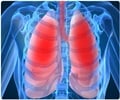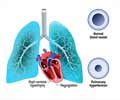Although increased use of noninvasive positive-pressure ventilation (NIPPV) nationwide has helped decrease mortality rates among patients hospitalized with chronic obstructive pulmonary

Invasive methods often involve a significant risk of infection which can occur when bacteria gather around the tube and its fittings. As a result, NIPPV methods are used when possible to minimize infection risks. NIPPV relies on the use of a mask to deliver pressurized air through the mouth and nose. The two common forms of NIPPV are continuous positive airway pressure (CPAP), which provides a continuous pressurized stream of air, and bilevel positive airway pressure (BPAP), which offers different pressures for inhalation and exhalation."
We performed the first examination of the patterns and outcomes of NIPPV treatment for acute exacerbations of COPD in clinical practice nationwide, using data from an estimated 7,511,267 million hospital admissions in the United States during 1998-2008," said Fernando Holguin, MD, MPH, an assistant professor of medicine in the Pulmonary, Allergy and Critical Care Division at the University of Pittsburgh School of Medicine.
"The current study, to the best of our knowledge, is the first to report a dramatic shift towards NIPPV use for treating respiratory failure from acute exacerbations in the United States."The increase is consistent with results reported by investigators in smaller studies, he said.
For this study, researchers from the University of Pittsburgh, Emory University, the University of Illinois at Chicago and the University of Kentucky reviewed clinical patient data gathered by the Healthcare Cost and Utilization Project Nationwide Inpatient Sample (HCUP-NIS) database between 1998 and 2008.
The researchers examined changes in the frequency of NIPPV and IMV use from 1998 to 2008, and compared patient demographics, income status, payer type, hospital region and hospital type among patients who initially received NIPPV, IMV or no respiratory support after hospital admission.
Advertisement
They also found that despite a steady decline in mortality among most patients studied, patients who used NIPPV and were then transitioned to IMV had significantly higher mortality rates than other patients, and that the mortality rate in these transitioned patients increased during the study period while mortality rates of other groups declined. Patients in this group also experienced the greatest increase in hospital charges and longest hospital length-of-stay.
Advertisement
Dr. Holguin added that the overall trend toward greater use of NIPPV was likely due to several factors, including clinical trials linking NIPPV with a decrease in hospital mortality, increased confidence in using NIPPV and the ability to use NIPPV outside of the intensive care unit.
"These results suggest that healthcare providers should continue to be aggressive with the use of noninvasive ventilation for patients with acute exacerbations, but definitely should intensively monitor sick patients, intervene early in the absence of improvement, and carefully examine if transitioning to IMV is in the interest of a patient with a poor prognosis," he said.
Source-Eurekalert














